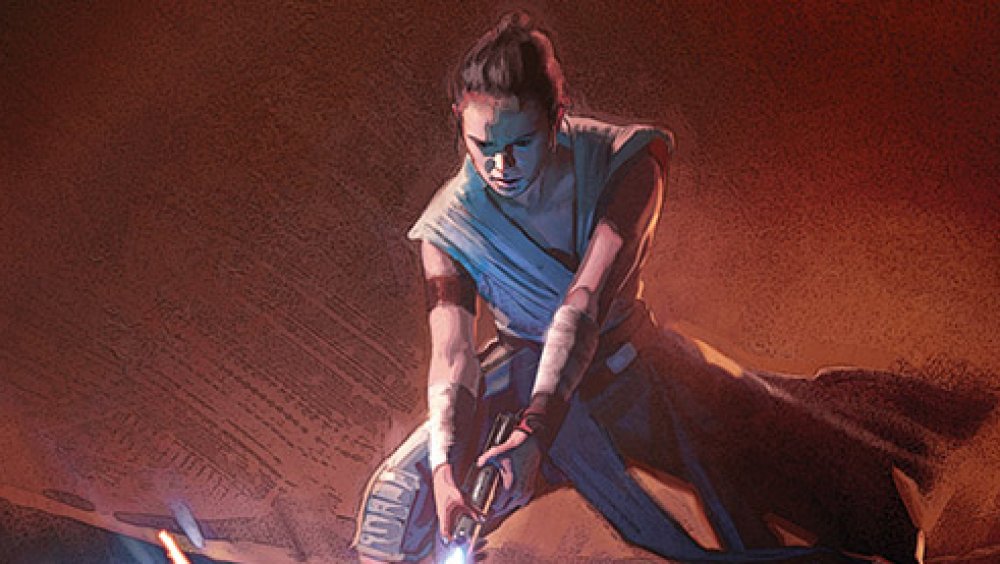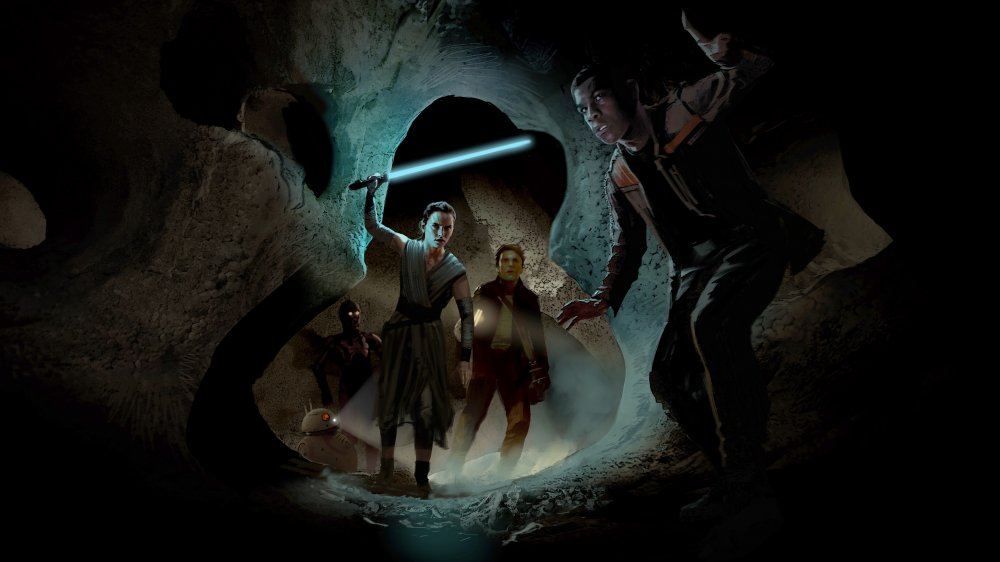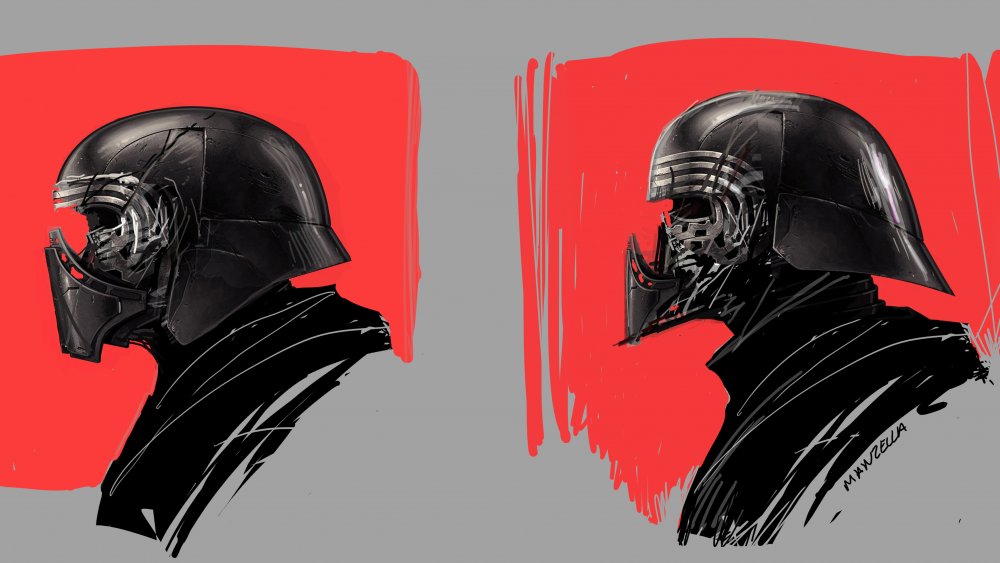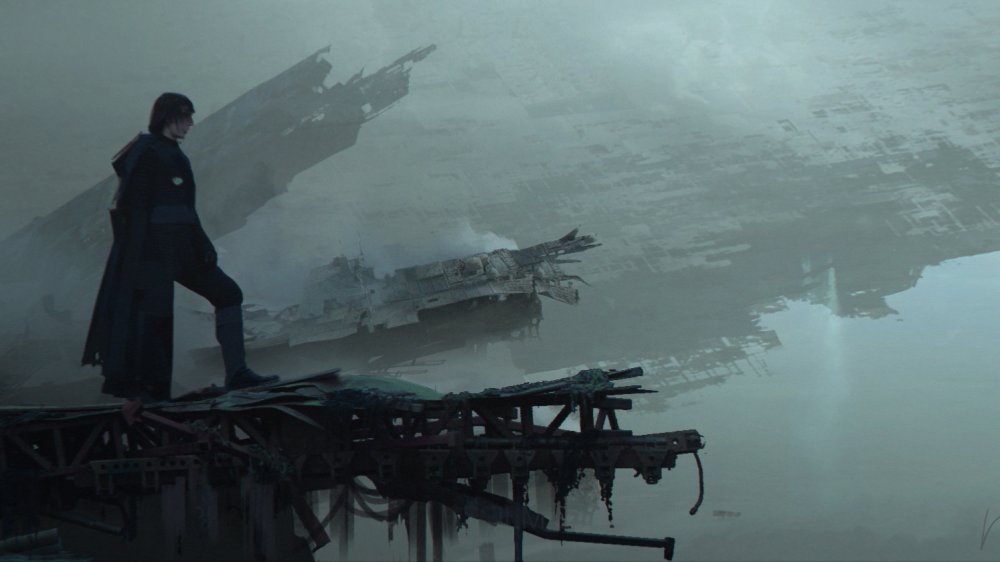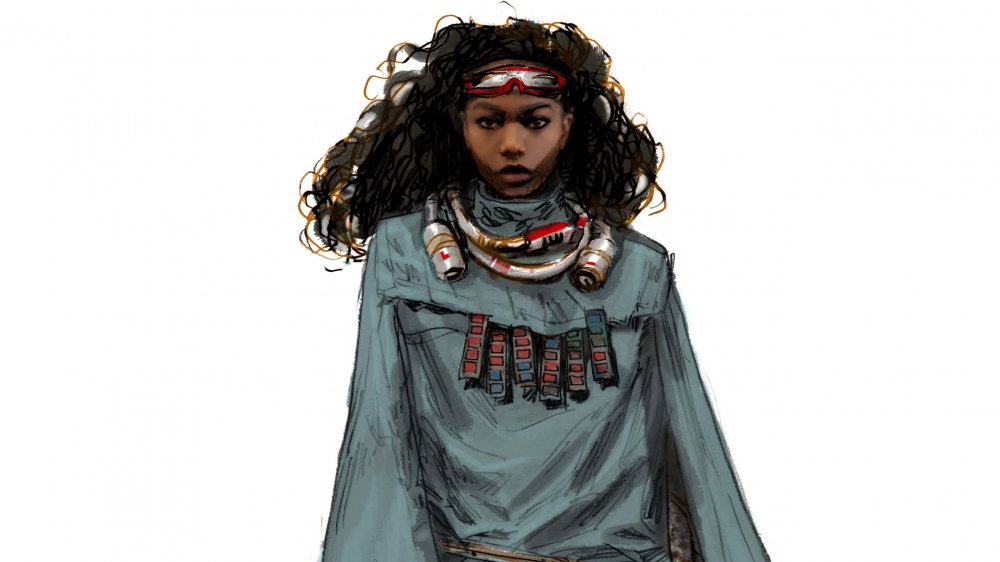Phil Szostak Spills On The Secrets Of The Art Of Star Wars: The Rise Of Skywalker - Exclusive Interview
Phil Szostak knows his Star Wars. Not only does he spend his days as Lucasfilm's creative art manager, where he's helped guide projects like The Mandalorian, Disney's new Star Wars movies, Marvel's spinoff comics, and plenty of tie-in novels, but he's also the author of four Star Wars art books, all of which offer intimate looks at how the latest Star Wars movies made it from pre-production to the big screen.
Szostak's latest, The Art of Star Wars: The Rise of Skywalker, is maybe his best yet. Not only is all of the artwork absolutely gorgeous, but the book is stuffed full of small details about The Rise of Skywalker's journey to the big screen. Using the art as a guide, Szostak walks the reader through the development of The Rise of Skywalker's controversial script. It's surprising how many of the big pieces of the movie fell into place early on. How much things were changing right up until shooting began is equally as striking.
A few days before The Art of Star Wars: The Rise of Skywalker's release, Szostak spoke with Looper about his work on the book and Episode IX's design process, sharing details about The Rise of Skywalker's ties to The Last Jedi, Palpatine's big return, his favorite Easter eggs, and much, much more.
How the Art of Star Wars: The Rise of Skywalker came together
Your title at Lucasfilm is "creative art manager." Can you talk a little bit about what that means and what you do?
The comparison that I usually make when talking about my job title, because it's a pretty vague title, is the Lucasfilm Story Group, which a lot of people are very familiar with. Pablo Hidalgo and Leland Chee and Matt Martin are the core of the story group that I interact with the most. As they are to story continuity within Star Wars, I am the design continuity guy. I'm like the design or art equivalent to what those guys do.
So, I'm tracking all new concept art as it comes in and redistributing it as needed, and I also do research for the Lucasfilm art department, which I'm a member of under Doug Chiang, who is a pretty popular name for Star Wars fans. So, I work within the art department and help them to get whatever Star Wars or other reference that they need.
I also work with the production art departments and the various art departments. There's a separate art department for props and costumes and creatures. So, I work with all of those teams to get them whatever reference they need as well. So, I'm kind of like a researcher. Another part of my job is going over various publications we're working on, like comic books and book covers. Anything with art in it I generally touch. I see a lot of the concept art for the various projects we're working on, be it TV, movie, animation, games. All that stuff crosses my desk.
Do you have an art background?
I do. I went to the School of Visual Arts in New York City. I went for film animation through that program there, and for a while I was self-publishing my own comic books, but The Art of The Force Awakens was the first book that I ever wrote. I never really thought I would be in the business of writing books. I'm very honored to be doing it. And through working at Lucasfilm, I befriended Jonathan Rinzler, who at the time was the lead editor at Lucasfilm publishing, and he's the one that saw potential in me for these books and suggested that I write them. I owe him a huge debt of gratitude for giving me that opportunity.
You guys produce so much art. How do you decide what to include in the book?
Yeah, it's literally tens of thousands of pieces for each one of these films. It's a crazy amount of stuff. A large percentage of those are just iterations on the same piece, but it's still a pretty huge number of things to sort through.
Kind of where I start from, there's actually a sorting that already kind of happens, a selection that happens of concept art called — and it was coined by the co-production designer on The Force Awakens and The Rise of Skywalker, Rick Carter, who a legend in the film industry as a production designer — Rick coined this term called "the moviescape," and the moviescape is a single PDF that runs you through the entire movie start to finish in concept-art form. That's like the blessed concept art from the art department, and that's always my jumping off point for the entire book.
It's a couple of hundred pieces, usually, but it doesn't include stuff from the other departments like props and costumes and creatures. So, in those departments, I'm a bit more on my own, but I also like to show the process. The moviescape just includes the final designs, and of course I want to include a bunch of the designs that led to those final designs. But that's usually my jumping off point. I also do get sent a playlist by some of the artists. In this case, the other production designer on the show, Kevin Jenkins, sent me a whole playlist of concept art to bounce off of, things that he thought were kind of worthy of being in the book s.
But the ultimate decision does come down to me, and my favorite thing is to go into our database and just start digging around in those folders, because there's always going to be some gems in there. Oftentimes, the artists themselves don't even remember doing the pieces. They were done so long ago, and just one day they had some kind of crazy idea. It's a lot of fun to kind of dig around and see what I can find and hopefully include in the book.
Why The Rise of Skywalker let its artists cut loose
This is your fourth Star Wars art book. From a design standpoint, what makes The Rise of Skywalker a unique film?
You know, I felt like there was a bit more freedom from the filmmakers, the storytellers, and the designers to go wild with this movie.
The Force Awakens was tough because it was partly kind of rediscovering and remembering like what the Star Wars aesthetic was, especially the original trilogy aesthetic, since these films are obviously a sequel to those films and not the prequels. Love the prequels, everyone loves the prequels, but Episode VII is the sequel to Episode VI. So, just rediscovering Ralph McQuarrie and that base. What is the Star Wars aesthetic? Everyone kind of finding that, and then wanting to be careful not to stray too far from that, to remind the audience of what they love about Star Wars.
Whereas, with this film, I think there's more freedom to explore and get a little wild and try some new things and kind of push the limits a bit while still retaining our core characters' — especially Rey and Kylo Ren's — iconic looks and not deviating too far from what we love about the characters that we've already established.
One thing I noticed while reading the book is that the story evolved with the art. Was there anything in the film where the art took lead and helped shape the final script?
I think they always kind of work hand in hand, especially in the early days. If you read The Art of The Force Awakens, it's really clear that there's this early stage that's called the "concept stage," where the writers are writing and artists are iterating and they're feeding each other. An idea will come from the writers, the art department will get that, and their art will then inform the direction that the story goes. That was definitely the same with The Rise of Skywalker.
The Oracle, which of course wasn't in the final film, is kind of a fascinating part of the book. Jake Lunt Davies' instinct to kind of make it this big baby head, which is a very kind of Miyazaki-inspired look, then informed the way the character was expressed in the script and what they shot, which hopefully at some point will be revealed.
Definitely the Kylo Ren helmet being informed by Kintsugi, which is the Japanese art of repairing pottery. That was something that I think everyone kind of came to simultaneously. It's weird. The creature department, which was designing Kylo Ren's helmets, and Glyn Dillon, who's the chief costume designer on this show, and J.J., were all thinking the same thing. They all kind of arrived at it at the same point at the same time. It's really hard to say who thought of it first. But when the idea of repairing the helmet came into being, they all kind of arrived at Kintsugi being the inspiration.
I think that design expresses something about who Kylo Ren is in this film, as well. He's kind of taking a step back into the Kylo Ren of The Force Awakens and trying to find that dark side place to exist within. That's my interpretation. He's been rejected by Rey in The Last Jedi and he's reaffirming his darkness in a sense by repairing the helmet, but it's cracked, just like his lightsaber blade is jagged. He's not a fully formed dark side being ever in these films.
The Art of The Rise of Skywalker opens with The Last Jedi. It doesn't go straight into The Rise of Skywalker. Were there ways in which The Last Jedi influenced the look of The Rise of Skywalker? Because they're very different looking films.
I think that's something that some fans might not like, the fact that this trilogy of films isn't more unified as a whole, but I think the only trilogy in Star Wars that has that unity of look and purpose is the prequels because those are the only ones that were all done by the same filmmaker. The original trilogy, they're all directed by a different director and oftentimes there were different teams working on those films.
But for The Last Jedi, because a lot of these movies are happening kind of simultaneously, and Rogue One and The Last Jedi were being developed at the same time, we had split the team that worked on The Force Awakens into two. Then production designers often bring designers who they've worked with on previous projects onto the film. Rick Heinrichs, who was the production designer on The Last Jedi, did that with that film.
They definitely have different aesthetics, but that's kind of what you're paying for. You're hiring someone like Rian Johnson who brings in Rick Heinrichs as production designer and you want a Rian Johnson film. At least that's what I wanted, and I think that's what we got, and I love that movie. At the same time, J.J. is going to bring a different aesthetic and a different sensibility to his films, and as long as it's still Star Wars and as long as it's still in the pocket of what's loved about Star Wars, I think it's fine.
I have heard J.J. say in interviews that he felt The Last Jedi gave him some more freedom to explore. He really liked how bold it was and felt more freedom in approaching The Rise of Skywalker than he might've felt with The Force Awakens, which of course had the heavy, heavy burden of bringing Star Wars back after 10 years.
How The Rise of Skywalker honors George Lucas' legacy
Both Doug Chiang's forward and your intro talk about George Lucas a lot, even though he wasn't directly involved with this movie. From a design perspective, what's the most important way that The Rise of Skywalker carried on Lucas' legacy?
As the final film in the Skywalker saga, it was important to both me and Doug, both of us having worked with George directly — I ran the art department up at the Skywalker Ranch for George for a number of years, and of course Doug's role as lead designer on Episode I and II —we're always thinking about George and we talk about George all the time in the art department. Obviously, Dave Filoni, who we worked closely with on The Mandalorian, is like a disciple of George's.
So, trying to capture that kind of casual aesthetic and not dwelling on designs and making things feel integrated and whole. Just, like, a casual approach to design. The designs are obviously worked on with a lot of effort, but the way that they're expressed in the film is very casual. Everything's kind of mixed and matched.
In a weird way, it's a very Zen thing. It's like the aesthetic of Star Wars is no aesthetic, because if everything just looked the same, it would look like a film set or a film prop or whatever. It wouldn't look like a real place. Obviously, everything in our world is just a mix of a jumble of stuff. I look around my room right now, and it's a jumble of stuff from many different places.
So, it's just keeping that kind of basic thing in mind, and I think it's something that J.J. understands inherently. Someone who's part of the same generation as me and Doug, growing up with the original trilogy films, it's something that you just kind of absorb and is expressed in who you are as a creative person. When it feels right, it feels right and when it's wrong, it's wrong. I think J.J.'s instincts are pretty spot-on for that.
There's not really anything in the book about Palpatine. Is there a reason why he's not there?
It's a pretty simple reason. There's no grand conspiracy here or anything. It's purely for security, for preserving the surprise for the audience seeing the movie, because this book went to print six months prior to its original release date in December and if, God forbid, pages leak out or the book gets shipped to bookstores and the bookseller opens the box.... That actually did happen on The Force Awakens. Snoke was revealed a bit early because Snoke appeared in The Art of The Force Awakens. So just avoiding that is purely what it comes down to.
Plus, with Palpatine, his look did not deviate too far from the Palpatine we knew from the prequels and the original trilogy. It wasn't this huge design evolution or anything. It's Palpatine. We know who he is. I mean, it would've have been great to include Glyn Dillon's designs for Palpatine in the book, but we didn't want to spoil that surprise.
It was revealed well in advance of the film, but we have no way of knowing that when we we're putting these books together, and we don't want to be the ones to reveal it. Yeah, I don't want to be the one responsible for letting that go. So, that's purely what that's about.
Given that, can you talk a little bit about the design process behind Palpatine's lair on Exegol?
The design of Exegol, a lot of exploration with different kinds of Sith temples were looked at, and the throne is based on some sketches that Ralph McQuarrie did for Return of the Jedi. In Return of the Jedi, when we meet Palpatine, at one point it was going to be on the planet that eventually became Coruscant, at one point it was like a volcanic layer, blah blah blah. So, he did some designs for Palpatine's throne in Return of the Jedi that Kevin Jenkins, the co-production designer for Rise of Skywalker, remembered and copied almost exactly.
We're always looking, digging around into those classic trilogy designers, Ralph McQuarrie or Joe Johnston or Nilo Rodis-Jamero, digging around in their unused pieces and sketches for any kind of inspiration because their stuff is just so inherently Star Wars. The shape of that throne just instantly evokes like a spider or a hand or just those like kind of tendrils coming out of it. It has this creepy, ominous, Gothic menace to it.
So, that was just a really obvious place to go. Well not obvious, because there are only like two or three little pencil sketches by McQuarrie of that shape. I think it's actually, in the McQuarrie sketch, it's a shadow being cast off of the throne, not the throne itself that shape, but it works perfectly for its use in the film. Anything McQuarrie does is iconic, so it was a no-brainer.
Were there any other designs that were leftovers from the original trilogy that made their way into The Rise of Skywalker?
Off the top of my head, that's the most obvious one. Obviously, the crashed second Death Star was an idea that was bouncing around in the early days of The Force Awakens, which a lot of people picked up on right away when they saw that in the trailer. So that's kind of cool. It was great for J.J. to get a second opportunity to use those ideas.
Actually, when I interviewed Chris Terrio at Pinewood Studios in his office, he said that he had The Art Of... books on his desk and that he was a big fan of them, and that was extremely flattering. Just as in the art department we look at Ralph McQuarrie's work for inspiration, it was kind of fun to hear that the books that we're putting together based on these films are already inspiring Star Wars filmmakers like Chris Terrio.
The Art of Star Wars: The Rise of Skywalker is full of small Easter eggs for hardcore fans
The book points out all these Easter eggs, like all the 2001 references in the movie and the little trinkets surrounding John Williams representing his 51 Oscar wins. Do you have a favorite Easter egg in the movie?
The one that just popped into my mind was the original B1 battle droid that's in Babu Frik's workshop. I have a particular fondness for Doug Chiang's design of the battle droids from the prequel trilogy. I especially love how they kind of mirror their creators. In the case of the battle droids, they look like the Geonosians, the insect dudes with the wings. The clone trooper armor is white and has the big eyes like the Kaminoans who created the clones. So, I just love that kind of connection, that kind of subtle undercurrent of believability and thought that went into those designs.
I think Doug Chiang has mentioned that that design was based on African sculpture. For the battle droid, skeletal, very much like the original storm trooper is based on a skeleton, but even more skeletal with the droid, taking out the sort of human figure inside of it. So yeah, just that's probably my favorite Easter egg. Just cool to put a touch of the prequels in there in a real subtle way in Babu Frik's workshop.
So, I have to ask, on page 158, with no explanation, there are paintings of Admiral Ackbar and Kit Fisto's skulls on pikes. What in the world is going on there?
I think those were going to be potentially surrounding the Oracle there. They were going to be just skulls on pikes. Those weren't intended to be necessarily those characters' heads. They're just the skulls of aliens of those same species, just as a warning or some kind of dark side thing, you know? I think it was probably deemed to be too dark, too weird, but I couldn't resist including them in the book.
The other spread that really kind of blew me away were the pages from the original Jedi books. Do you know how intentional those designs were?
There's actually a whole separate graphics team that is responsible for those, and Dan Burke's team just does amazing work. I have befriended online some people who are experts in ancient manuscripts, and they love that stuff, the Jedi texts. Obviously, they are bouncing off of actual historical manuscripts and documents. It's way above my level of expertise. I just look at them and my mind kind of goes blank. I'm just like, "Wow. Where do you even begin to make something like that?" You know? It's really amazing.
Yeah. It's all just a made up language, and of course they're trying to connect the illustrations within those texts to plot points in the film to give J.J. the freedom to use them in any way that he wishes within the film, to showcase them and have a hand go over them if there's dialogue or whatever. So yeah, oftentimes the design teams are trying to give the filmmakers flexibility to use those. It's amazing work. I'm always blown away by the graphics team. Dan Burke and his people are amazing artists.
Obviously, you just wrote a whole book about this, but is there anything about The Rise of Skywalker that you haven't gotten to say yet or that you think people haven't noticed deserves more attention?
I structured the book the way that I did, having it be structured by department, to pay tribute to these amazing artists who have worked for the last five years on almost nothing but Star Wars, and to really hammer home in the readers' heads what these people are responsible for and how amazingly talented they are.
Some artists that are better known than others, and one that jumps out to me as being kind of an unsung hero of this trilogy and of the past five films in general is Matthew Savage, who is the props costume artist and who singlehandedly designed every single blaster, lightsaber, jet pack and gadget in all the films, which is pretty astounding work.
So yeah, I've been saying this a lot, but the way I thought of this book was as a victory lap for all the departments, because they just knocked it out of the park. Amazing work all around. That's how I've been thinking about this book, hoping to emphasize what each department's responsible for and just how amazing the work they've consistently done over the past five years has been.
